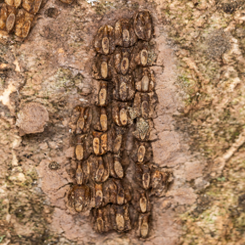Hop, Skip + a Jump

A hop, skip and a jump – you may be wondering if this blog is about short distance. The answer to that is… sort of! This blog is all about the pests that hop and jump from one plant to the next.
On September 3rd, 2020; John Esslinger from the Penn State Extension authored an article about “challenging pests” in Pennsylvania. This article was focused on Jumping Worms; also known as snake worms. Jumping worms are relatively new to the state and there is not a ton of known information on them. However, what we do know is this; these worms are extremely destructive to the soil quality, as they consume large quantities of organic matter, grow quickly and spread rapidly.
 Nancy Knauss wrote in her 2018 article, that the best way for us to stop the spread of these jumping worms is to be careful when exchanging plants and bringing new plants into your garden. Check for a “coffee ground” like soil. If you see that, rinse the roots of the plant to remove the soil prior to replanting.
Nancy Knauss wrote in her 2018 article, that the best way for us to stop the spread of these jumping worms is to be careful when exchanging plants and bringing new plants into your garden. Check for a “coffee ground” like soil. If you see that, rinse the roots of the plant to remove the soil prior to replanting.
 Next on the list is a viral-like disease that is transmitted by leaf-hoppers. Aster yellow is caused by a phytoplasma, according to the Missouri Botanical Garden. Insects who suck the sap of infected plants become carriers. Coneflowers, zinnias, marigolds, chrysanthemums and petunias are just some of the 300 species Aster yellow can affect. There is no current cure for this disease but here are some pest management strategies recommended by the MBG:
Next on the list is a viral-like disease that is transmitted by leaf-hoppers. Aster yellow is caused by a phytoplasma, according to the Missouri Botanical Garden. Insects who suck the sap of infected plants become carriers. Coneflowers, zinnias, marigolds, chrysanthemums and petunias are just some of the 300 species Aster yellow can affect. There is no current cure for this disease but here are some pest management strategies recommended by the MBG:
+ control the weeds and insects in your lawn and garden (see below about contacting us for a free estimate)
+ remove the infected plants
+ plant species of plants that are not as susceptible to aster yellow such as impatiens, cockscomb, and geraniums
 One more to go – those spotted lanternfly had to make a spot on our list of pests. As you know, we have two treatment programs to help control and eliminate SLF. Donald Seifrit from the Penn State Extension, created a video (that you can watch here) of how to remove spotted lanternfly egg masses. SLF lay their eggs in the fall season, so masses can be visible anywhere from October through July, and hatching usually begins in May. Seifrit notes that once you find them, they are simple to destroy so check for flat surfaces in your outdoor space to find the egg masses and scrap them off.
One more to go – those spotted lanternfly had to make a spot on our list of pests. As you know, we have two treatment programs to help control and eliminate SLF. Donald Seifrit from the Penn State Extension, created a video (that you can watch here) of how to remove spotted lanternfly egg masses. SLF lay their eggs in the fall season, so masses can be visible anywhere from October through July, and hatching usually begins in May. Seifrit notes that once you find them, they are simple to destroy so check for flat surfaces in your outdoor space to find the egg masses and scrap them off.
In each egg mass there are usually 30 to 50 eggs. So catching them early is best for the next season. If you are interested in learning more about spotted lanternfly and about the lawn care treatments we offer at Indian Run – check out our blog here.
Contact us with any questions you may have about possible infected plants or pests. And if you are ready for the fall lawn treatments, aerating and overseeding – schedule an estimate today!

Leave a Reply